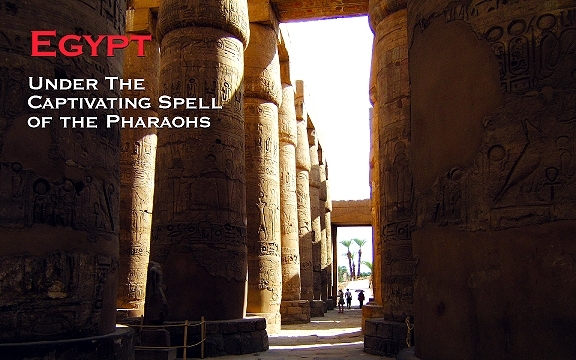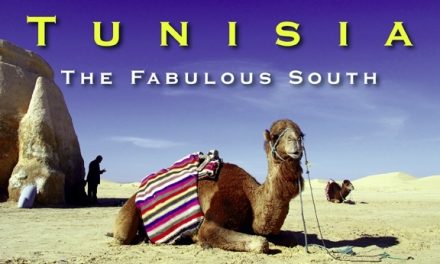Egypt
Under The Captivating Spell of the Pharaohs
Published in the Spring 2010 Issue of Canadian World Traveller
By Habeeb Salloum (habeeb.salloum@sympatico.ca)
Viewed from atop the Cairo Tower, the mighty Nile appears to be overwhelmed by the many luxury hotels and towering apartment buildings that line its banks.
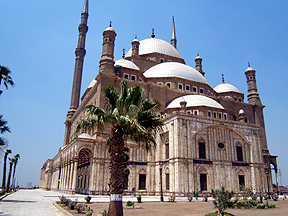 Beyond this legendary river, Egypt’s capital city spreads out to the horizon, its streets overcrowded with a constant stream of humanity.
Beyond this legendary river, Egypt’s capital city spreads out to the horizon, its streets overcrowded with a constant stream of humanity.
In between the avenues with their masses of zigzagging autos, one sees what looks like at least a thousand minarets of historic and newly built mosques, peppered with a number of Coptic-Christian basilicas. Metropolitan Cairo is home to some 18 million inhabitants.
The city is a heady mix of Eastern exoticism and Western sophistication, making it an interesting place to visit. Yet, this is not what the millions of people travelling to Egypt want to see.
Glimpse of the Great Pyramids
Turning to the other spectacular view from the tower, visitors can catch a glimpse the outline of the Great Pyramids in the distance.
Located on a desert plateau on the western edge of the city, these imposing age-old structures are the true magnets that draw countless tourists to Egypt each year.
North Americans and Europeans, travelling in tour groups, usually make a short stop in Cairo, the cultural capital of the Arab world. But they never really explore Africa’s largest city.
They usually spend one or two days visiting the Egyptian Museum of Antiquities and the Great Pyramids, then are whisked southward to see the other astounding works of the ancient Egyptians located around Luxor and Aswan.
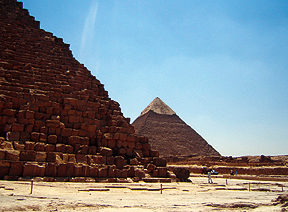 Only Wonder of the World
Only Wonder of the World
Perhaps the tour operators have a point when they steer their groups toward Egypt’s world-renowned, timeworn monuments.
By any standard, the Great Pyramids, the only original ‘Seven Wonders of the World’ still standing, is an unbelievable accomplishment of ancient man.
It is said that there is no traveller viewing them for the first time who has not gasped in awe, overwhelmed by their majesty.
With their guardian the Sphinx, the pyramids stand on a desert plateau some 15 km (9.3 miles) from the heart of Cairo.
Since the days of ancient Greece and continuing into modern times, the Great Pyramids have been visited, written about and explored at length. Today, they are recognised as part of world mythology.
Truly Great Pyramids
Called the Giza Pyramids to distinguish them from the other 108 pyramids found in the country, the Pyramids of Cheops, Chephren and Mykerinos stand immutably majestic – the most famous of all the many attractions of Egypt.
The largest and oldest of these is the Great Pyramid of Cheops, erected about 2590 B.C. Its base covers 6 hectares (13 acres) and it is estimated to contain 3 million separate blocks of stones, each averaging 2 1/2 tons.
Once, these pyramids and others played a vital role in the lives of Egypt’s kings and its peasantry. For many, today they are the trademark of lasting power, drawing tourists from around the globe, as well as dabblers in magic and believers in extra-terrestrials.
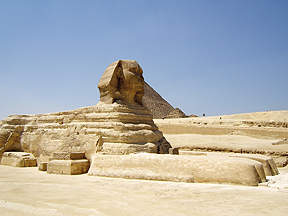 Under the Watchful Eye of the Sphinx
Under the Watchful Eye of the Sphinx
Watching haughtily over the pyramids is the nearby equally famous Sphinx, carved out of solid natural rock by Chephren (son of Cheops), who was the builder of the second pyramid.
He had this huge statue sculptured from soft limestone with a lion’s body and a god’s face, believed to be his own likeness.
For over 45 centuries, the Sphinx has defied the passing of time, witnessing all the morning suns civilized man has ever seen.
Carved in the midst of temples, which are in the process of being excavated, this half-man, half-beast statue has acquired, through the centuries, an air of mystery and romance.
Sound and Light Shows
The magnificence of the pyramids and the Sphinx are superbly portrayed in the ‘Sound and Light’ shows, presented nightly.
After sunset throughout the year, on different nights presented in Arabic, English, French and German, these shows, the finest of their kind presented anywhere, draw tourists by the droves.
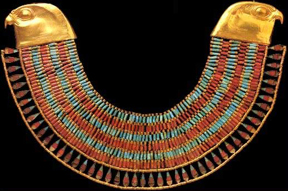 Museum of Antiquities
Museum of Antiquities
By contrast, more thrilling to many tourists is the Egyptian Museum of Antiquities, which houses some 100 thousand exhibits.
It contains a very rich store of remains from the ancient Egyptian civilizations, including the 4,000-piece treasure found in Tutankhamen’s tomb. Few museums in the world can even come close to its impressive exhibits.
Auguste Mariette, the great pioneer archaeologist, built this huge classical-style museum in 1853, but its collection has only occupied the building since 1902. Days are needed to truly appreciate the exhibits, not the half-day or one-day tours allotted time for most visitors.
After this storehouse of priceless ancient treasures, one becomes eager to explore the boundless Pharaonic monuments around Luxor and Aswan where, it is said, half of the world’s important ruins are to be found.
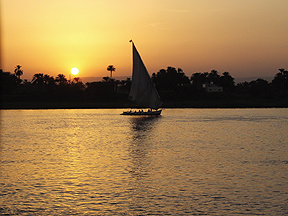 Unforgettable Nile Cruise
Unforgettable Nile Cruise
The best way to see the most important monuments of Upper Egypt is to take a Nile cruise from Luxor to Aswan.
Luxor, the Pharaonic Thebes, then a city of a half a million, was divided by the ancient Egyptians into two parts – on the East Bank of the Nile, the City of the Living and on the West Bank, the City of the Dead.
Two of the ten temples on the East Bank, the Karnak and Luxor Temples, where the gods lived, still greet the sunrise; and the sunset on the West Bank continues to throw shadows over the 400 tombs located in the Valleys of the Kings, Queens and Nobles as well as Queen Hatshepsut’s Temple.
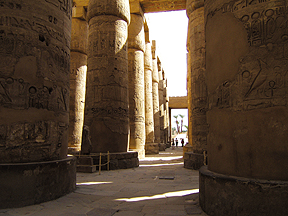 Karnak & Luxor Temples
Karnak & Luxor Temples
The city’s most important monument, the Karnak Temple, dedicated to the god Amon-Ra, was for the ancient Egyptians, a highly revered place.
Covering over 40.5 hectares (100 acres) and spanning 13 centuries, the complex is today a massive collection of ruins. At one time 81,000 people toiled here in the largest series of temples ever built in one complex.
In both the Karnak and Luxor Temples, the imagination runs wild for the thousands upon thousands who take this thrilling walk through history.
Strolling beneath pillars decorated with carvings of lotus buds and the papyrus plants; walking past statues of gods and animals; or climbing down into fantastically decorated tombs, the visitor is never far away from the early Egyptians and their remains.
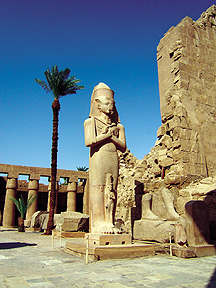 Khnun: Ram-headed God
Khnun: Ram-headed God
After viewing the many wonders of Luxor, visitors begin their Nile cruise to Aswan.
The ship’s first stop is at Esna, 64 km (40 mi) to the south. Its temple is dedicated to Khnun, the ram-headed god who is said to have modelled humans on his potter’s wheel. The temple is a Ptolemaic building with Pharaonic, Greek, Roman and Coptic elements.
At one time, it was completely concealed by debris and sand. This kept the hypostyle hall with its forest of 24 columns, 13 m (43 ft) high and topped by capitals depicting flowers and plants, in almost perfect condition.
Horus: Falcon-headed God
The next stop, Edfu, 123 km (76 miles) north of Aswan, has the best preserved of Egypt’s 100 temples, which were built to honour some 750 gods.
Again the sand, which for centuries had covered the temple, was responsible for its preservation.
Dedicated to the falcon-headed god, Horus, the most famous deity in Upper Egypt, it is covered inside and out, with mythological and religious decorations, bas-reliefs and hieroglyphic texts.
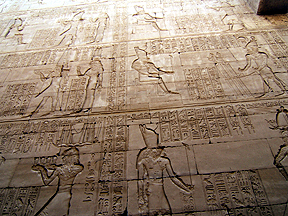 Kom Ombo: Temple of Fertility God
Kom Ombo: Temple of Fertility God
& Medicine
Before reaching Aswan, the ship stops at the Temple of Kom Ombo, dedicated to Sobek, the crocodile god of fertility, and Haroeris, the Good Doctor.
Built a few centuries before the Romans occupied Egypt, the temple also served as a hospital. A whole series of medical instruments are sculpted in bas-relief on the temple walls.
Captivating Pharaohs
At Aswan, the Philae Temple and, to the south, the Temple of Abu Simbel (both moved due to the elevated water level created by the High Dam) continue to draw thousands of visitors each year.
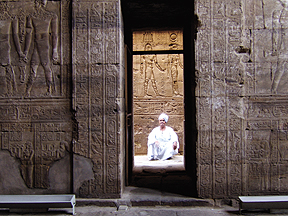 From Cairo to Aswan and beyond, these and the dozens of other temples dedicated to the Pharaohs’ gods captivate tourists in the millions.
From Cairo to Aswan and beyond, these and the dozens of other temples dedicated to the Pharaohs’ gods captivate tourists in the millions.
Considering the amount of international tourism income that these ancient Egyptian monuments continue to generate for the country each year, there can be little doubt that the god-king Pharaohs are lending an invaluable hand to the quality of life in modern-day Egypt.
More Info About Egypt:
Egyptian Tourist Authority in Canada
2020 University, Suite 2260
Montréal, QC H3A 2A5
Tel.: 514-861-4200
Fax: 514-861-8071
Email: info.ca@egypt.travel
Official Website: www.egypt.travel

